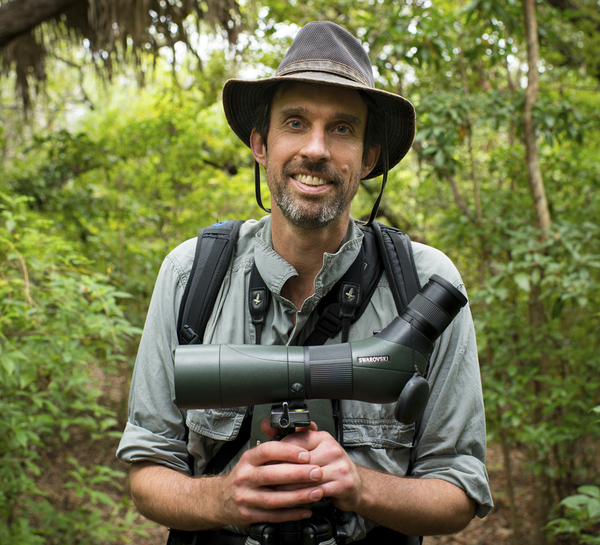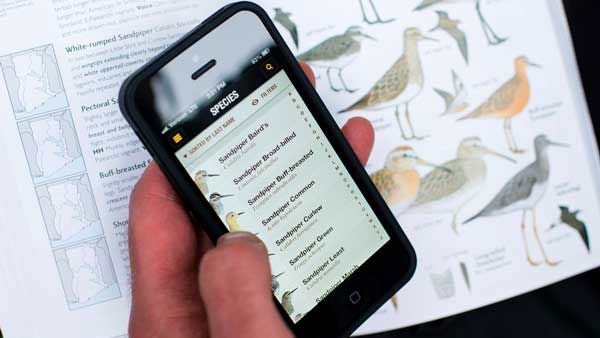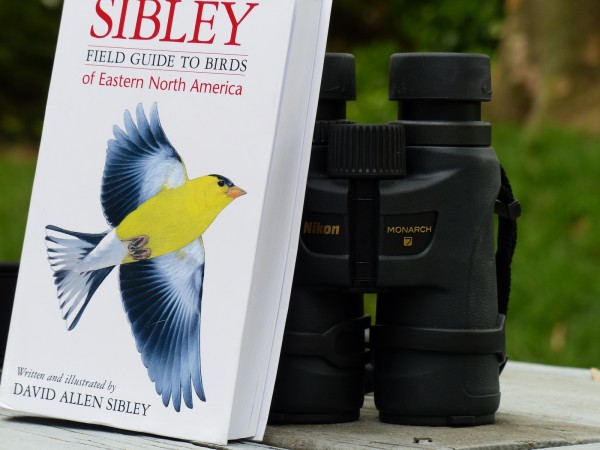As I lay prone and shivering on my suburban front yard—in my pajamas and in full view of my neighbors—watching through binoculars as a turkey vulture picked apart the last earthly remains of a road-killed gray squirrel, I pondered the chain of events that had brought me to this moment.
It started when my editor had an idea for a blog series that essentially amounted to a kind of dare: Could you, he wondered, become a competent, if not expert, birder in the space of about four months?
Me? I said. Probably not.
Though I have long had an interest in birding, I have an equally long history of birding failure.
Which, go figure, apparently makes me perfect for what he had in mind.
Go forth, he said, and become an expert birder by the end of June. And, oh yeah, there’ll be a test at the end to measure your progress. Don’t embarrass yourself.
Becoming a Birder: the Mentor
Fortunately for me, the Zero to Hero: Birding assignment also comes with a world-class birder as a mentor: Tim Boucher. For his day job, he’s a geographic information systems (GIS) scientist at the Conservancy and blogs regularly about birds for Cool Green Science. He’s also well known as a birder’s birder, the kind who treks deep into the rainforest to catch a glimpse of a Bornean Bristlehead, and has traveled to more than 45 countries, braving civil wars and landslides, in pursuit of birds.

Once the news gets out that Boucher is showing me the birding ropes, other Conservancy birders occasionally stop me to express their jealousy.
Boucher is clearly a star and I’m hopeful that with such an accomplished and dedicated guide, this attempt – with the extra motivation that comes with the potential for public humiliation – will not end in frustration, failure, and ignominy.
I have visions of being Twitter-shamed by David Sibley because I can’t tell a house finch from a song sparrow.
I am really counting on Tim, and though he may not know it yet, he has his work cut out for him.
The Course of Study
“Best way to learn to bird,” he says at our first meeting, “is to go out and bird. Do you have a backyard?”
Yes. I live in suburban Maryland, not far from Annapolis. I have a yard and a couple of small parks near my house.
“Perfect. Here’s your homework: you need a good bird guide and good binoculars. Good binoculars,” he says again. “Not ‘opera glasses.’ Download and install Merlin on your phone. Set up an account at eBird. Spend some time watching and identifying the birds in your yard. Keep a list.”
That’s it? He eyes me in a way that makes me think he actually does know just how challenging this project might be. “We’ll start small,” he says. “And work our way up.”
It’s pretty far up. By the end of June, my goal is to be able to lead a credible (and enjoyable) bird walk. I’ll need to be adept with my binoculars and helping people find birds.

Building the Foundation
To build my foundation as a birder, I’m spending the weeks between now and then identifying and recording as many species as possible (using both the amazing Merlin app and eBird).
I’m also working on the dark art of identifying birds by their songs and calls, which is one of the necessary skills of an expert birder.
It’s “identifying birds by their songs and calls” that actually worries me the most. I’ve tried that before. Several times.
The same thing always happens. I listen to a series of calls and songs on a CD or an app until I can identify them reliably by ear. And then, I go out into the woods or traipse across a grassland and there are so many birds calling and singing. It’s overwhelming.
For me, trying to pick out an individual bird species by its song in the wild is like standing on the corner of State Street in Chicago at rush hour and trying to identify the make of a car by the sound of its horn.
A definite area of birding growth for me.
Wish Me Luck
I’ll be checking in on the blog every week as I work on my skills. Right now, I’m practicing on the robins, crows, and cardinals in my yard. I also seem to have developed a somewhat unexpected (and possibly concerning) fascination with turkey vultures.
I understand that for many people, the birding obsession starts with warblers or shorebirds, woodpeckers or swallows, or some other bird of particular beauty or rarity or with a haunting, melodious song.
Sadly, I do not seem to be one of those people.
No, I seem to be the kind of person who becomes obsessed with a big, black bird that eats road kill and has a head so starkly bald and red it looks like all the feathers might have been scalded off in a catastrophic and disfiguring industrial accident.
Poor Tim. I don’t think he knew what he was getting into.
If you have any birding tips or words of advice for a newbie, please leave them in the comments. All help and encouragement appreciated.
eBird species list to date: 22
Next time: I start on my reading list and go on a guided bird bird walk.





I’m looking forward to following your progress and trying some of tips as well. I’m a birder and go out with more experienced folks as often as I can. I’m boggled very often. I’m learning and love it more and more all the time!
Best to you! Eagerly following you!
Robin
I’m with you: I love vultures, although I have a preference for the Black Vulture over the Turkey Vulture. Probably because I went to a presentation by a raptor rehabilitation group which brought some of their unreleasable birds with them and included a black vulture. They brought the “BV” around so we could touch her; she was gorgeous. Her feathers were so glossy, silky and soft. Your admiration is not misplaced! If you ever get a chance to go to that sort of presentation I highly recommend it (no guarantee on whether or not a “TV” would be present). Also: plan to go to a local “hawk watch” and check out the local list serves for bird sightings and walks in the area. And lament with us TNC WO old-timers that the office moved from Rosslyn, where we had easy access to Roosevelt Island. 🙂
Learning the calls is really important, and it is still my nemesis. But, in part by seeing the birds sing, and in part by hearing the recordings again and again (year after yr!), I’m making progress.
Also, go out regularly with other birders. That’s been a huge help for me.
Best of luck,
Bob
Wishing you the best of luck on your birding challenge. I am a new birdir and have a friend who is my mentor. Have boutht bird guides and like yourself I find it difficult to identify birds by their song in the wild.
Check out the Birdseye bird finding guide app, from the same developers as Merlin. It will show you all the other birds that are being seen around you by other eBirders, and can help you find them as well.
Good luck on your quest Cara. You are very lucky to have the assistance by Tim. Certainly the best way to learn is to be out in the field with someone who knows and can pinpoint to the fine details of bird identification.
For people who don’t have a mentor, a very effective way is to bird with a superzoom point and shoot camera. At the end of the day, you will have a photograph you can study and try to ID. If you enlist in a social media where it is allowed to post pictures of unidentified birds, you can get help from mentors on line. With a point and shoot camera you can also record video of singing birds and get that part as well.
I share with you the Facebook group Bird Identification Basics North America
https://www.facebook.com/groups/birdingschool/
and a blog post Birding With a Point&Shoot Camera.
http://birding.com.co/birding-with-a-point-shoot-camera/
Hope you and your readers find something useful here.
I am looking forward to following this series as well. I find in learning bird songs I need to focus on just one bird at a time. I too find it helps to see the bird singing. It also helps to be able to reproduce the sound myself, either by simple imitation or by using one of the mnemonic phrases that represent the sounds such as “Cheer up! Cheerily” for Robins. The very first bird call I learned was Chicka-dee-dee-dee. Don’t forget that birds use different calls in different seasons and for different reasons. Good luck!
I have been an ever evolving birder from my mom’s passion for them. I can identify quite a few and ID a half dozen songs or chips, but I am no way a pro. The way you are learning looks right up my alley. I am in the process of activating my son’s older iPhone and am very anxious to download Merlin and eBird. My go-to site has been Cornell University Ornithology. I used this site for a Bird Unit with my young students and they found so much information on their birds that they would write or call during the summer with all kinds of interesting questions. The best one.”Mrs.Lavallee, Why do the chickadees go to the feeder and then fly to a branch and peck at their feet?” Isn’t that an awesome observation and cool question? SO much to earn as a friend to our planet just by learning about birds!
Some birds soar and some Pearce. Also watch for gender as males have more color. With Hawks and eagles it’s meet to find the young and to be able to distinguish between male and female as their colors don’d differ. Above all have fun!
Go for it. You are inspiring me! My spouse is an excellent birder and I generally just “tag along.” Now inspired to join him using the Merlin site.
I too had a hard time learning bird songs in the past. Here is my solution: I set one short recording of a bird as my phone ringtone and another for my text message alert. You naturally get used to listening for your phone. In time, you’ll find yourself reaching for your phone, and discover it was a real bird singing. Xeno-canto.org is a good source for recordings.
Hi Charlotte — thanks so much for that tip. I’m going to try that today. I’ve finally mastered being able to ID robins, cardinals, grackles and white-throated sparrows “in the wild” so to speak, since I’m practicing in my yard.
What a great idea for a series! I know nothing about birding, so I’m looking forward to learning more.
The way that I learn bird song best is to watch a bird sing. The visual usually cements the song to the bird for me. Best of luck.
I’ve been working on that in my yard — and using the Merlin App from Cornell. That’s how I finally figured that white-throated sparrows were making that haunting, whistling call.
Excited to follow your journey and perhaps join in. 22 is fabulous beginning! Merlin is great, and I’ll have to look into eBird. Best wishes on your adventure!
~Lee
Hey Lee — please do join me. eBird has been very helpful in keeping track of the species (and the when and where of the sighting). It also gives you easy links to more information about the each species, which is how I ended up going down the turkey vulture rabbit hole. — Cara